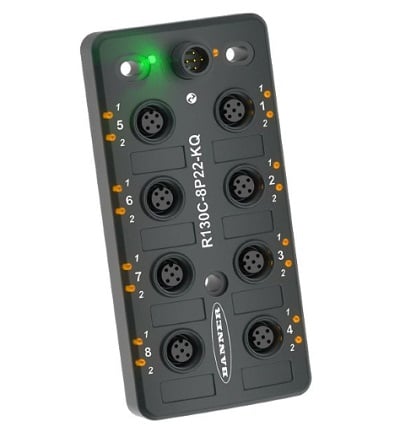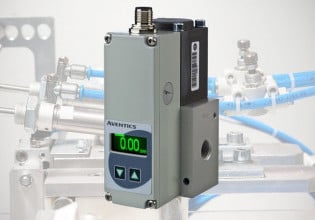Easily Integrate Smart Sensor Networks: Banner’s New IO-Link Hubs
Save space and time with Banner Engineering’s new R130C and the R95C series IO-Link hubs. These hubs allow customers to connect up to 16 sensors or actuators for wider network signal distribution.
Banner Engineering has released two new products within the IO-Link family of components: the R130C and R95C IO-Link Hubs. When combined with Banner’s IO-link Masters, these hubs can transmit 8-16 signals via IO-link to the customer’s HMI, PLC, or other network devices. Each hub is equipped with eight industry-standard M12 ports, where the input ports can be customized individually.
R130C Discrete Top Exit IO-Link Hub
The R130C IO-Link hub is a compact, top-exit IO-Link hub that allows integrators or machine builders to connect up to 16 non-IO-Link devices into an IO-Link system. The R130C hub allows the integrator or machine builder to be cost-efficient and save space thanks to its compact design and capabilities.

The R130C from Banner Engineering allows two discrete input or output channels to each of its eight M12 ports. Image used courtesy of Banner Engineering
Thanks to its industry-standard IP65, IP66, and IP67 ratings, the IO-Link hub can be mounted on the machine or closer to the sensors. This minimizes the wiring from the sensors to the hub and allows a single cable to be run from the cabinet to the hub.
This device is set apart from other IO-Link hubs in its ability to provide power to other devices with four amps shared across all eight ports. The additional current allows for power to be provided for lighting or other higher-current devices. The R130C also has I/O status LEDs which are visible from the top or side of the device, greatly easing troubleshooting for the device, regardless of mounting location.
Increased Versatility With the R95C IO-Link Hub
The R95C from Banner Engineering sets the standard for versatility when it comes to IO-Link hubs. The R95C has four different configurations that allow integrators to get exactly what they need. Each configuration is equipped with eight ports that use an IO-Link interface.

The R95C from Banner Engineering allows more versatility with multiple configurations and mounting options. Image used courtesy of Banner Engineering
The discrete I/O at each port is configured independently as either PNP or NPN, while the analog signals can also be independently configured to accept 4-20 mA or 0-10 V signals.
· R95C-4B4UI-KQ: Four discrete (2 in / 2 out) and (4) Analog In/Out.
· R95C-8B21-KQ: (16) inputs or (8) inputs / (8) outputs.
· R95C-8B22-KQ: (16) inputs or (16) outputs.
· R95C-8UI-KQ: 8-port analog I/O.

The stackable design of the R95C allows for easier cable management in a smaller space. Image used courtesy of Banner Engineering
Banner Engineering also added some slick features, such as a stackable design that allows for multiple units to be mounted in a smaller area. The R95C family also includes a unique side-exit port design that can prevent unnecessary cable bends and make cable routing much easier. The R95C series hubs also have a port mirroring. This allows for discrete or analog inputs to be mapped to one or multiple outputs on the same device.
Sensor Distribution with IO-Link
Banner Engineering’s R130C and R95C IO-Link hubs are designed to allow integrators to provide customers with an efficient solution for sensor integration, simplify wiring, and increase versatility in the design of automated machines.






